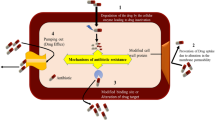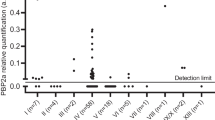Abstract
A total of 91 strains ofAeromonas (A. hydrophila, A. sobria, andA. caviae) of clinical origin were challenged in vitro against pooled human serum. A majority of the isolates ofA. hydrophila andA. sobria were resistant to the bactericidal activity of human serum, as opposed to the more serum-sensitiveA. caviae species. This difference in serum sensitivity may potentially explain the greater association of the former species with bacteremia and invasive disease.
Similar content being viewed by others
Literature Cited
Carruthers, M. M., Kabat, W. M. 1981.Vibrio vulnificus (lactose-positive vibrio) andVibrio parahaemolyticus differ in their susceptibilities to human serum. Infection and Immunity32:964–966.
Daily, O. P., Joseph, S. W., Coolbaugh, J. C., Walker, R. I., Merrell, B. R., Rollins, D. M., Seidler, R. J., Colwell, R. R., Lissner, C. R. 1981. Association ofAeromonas sobria with human infection. Journal of Clinical Microbiology13:769–777.
Goodwin, C. S., Harper, W. E. S., Stewart, J. K., Gracey, M., Burke, V., Robinson, J. 1983. EnterotoxigenicAeromonas hydrophila and diarrhoea in adults. Medical Journal of Australia1:25–26.
Gracey, M., Burke, V., Robinson, J. 1982.Aeromonas-associated gastroenteritis. Lancet2:1304–1306.
Hanson, P. G., Standridge, J., Jarrett, F., Maki, D. G. 1977. Freshwater wound infection due toAeromonas hydrophila. Journal of the American Medical Association238:1053–1054.
Janda, J. M., Raitano, M., Bottone, E. J. 1984. Biotyping ofAeromonas isolates as a correlate to delineating a species-associated disease spectrum. Journal of Clinical Microbiology19:44–47.
Joseph, S. W., Daily, O. P., Hunt, W. S., Seidler, R. J., Allen, D. A., Colwell, R. R. 1979.Aeromonas primary wound infection of a diver in polluted waters. Journal of Clinical Microbiology10:46–49.
Ketover, B. P., Young, L. S., Armstrong, D. 1973. Septicemia due toAeromonas hydrophila: clinical and immunologic aspects. Journal of Infectious Diseases127:284–290.
Lynch, J. M., Tilson, W. R., Hodges, G. R., Barnes, W. G., Bopp, W. J., Watanake, I. 1981. NosocomialAeromonas hydrophila cellulitis and bacteremia in a nonimmunocompromised patients. Southern Medical Journal74:901–902.
Moll, A., Cabello, F., Timmis, K. N. 1979. Rapid assay for the determination of bacterial resistance to the lethal activity of serum. FEMS Microbiology Letters6:273–276.
Popoff, M., Véron, M. 1976. A taxonomic study of theAeromonas hydrophila-Aeromonas punctata group. Journal of General Microbiology94:11–22.
Popoff, M. Y., Coynault, C., Kiredjian, M., Lemelin, M. 1981. Polynucleotide sequence relatedness among motileAeromonas species. Current Microbiology5:109–114.
Scott, E. G., Russell, C. M., Noell, K. T., Sproul, A. E. 1978.Aeromonas hydrophila sepsis in a previously healthy man. Journal of the American Medical Association239:1742.
Shotts, E. B., Gaines, J. L., Martin, C., Prestwood, A. K. 1972.Aeromonas-induced deaths among fish and reptiles in an eutrophic inland lake. Journal of the American Veterinary Association161:603–607.
Sirinavin, S., Likitnukul, S., Lolekha, S. 1984.Aeromonas septicemia in infants and children. Pediatric Infectious Diseases3:122–125.
Tamplin, M. L., Specter, S., Rodrick, G. E., Friedman, H. 1983. Differential complement activation and susceptibility to human serum bactericidal action byVibrio species. Infection and Immunity42:1187–1190.
Taylor, P. W. 1983. Bactericidal and bacteriolytic activity of serum against gram-negative bacteria. Microbiological Reviews47:46–83.
Von Graevenitz, A., Mensch, A. H. 1968. The genusAeromonas in human bacteriology: report of 30 cases and review of the literature. New England Journal of Medicine278:245–249.
Wolff, R. L., Wiseman, S. L., Kitchens, C. S. 1980.Aeromonas hydrophila bacteremia in ambulatory immunocompromised hosts. American Journal of Medicine68:238–242.
Author information
Authors and Affiliations
Rights and permissions
About this article
Cite this article
Janda, J.M., Brenden, R. & Bottone, E.J. Differential susceptibility to human serum byAeromonas spp.. Current Microbiology 11, 325–327 (1984). https://doi.org/10.1007/BF01567700
Issue Date:
DOI: https://doi.org/10.1007/BF01567700




